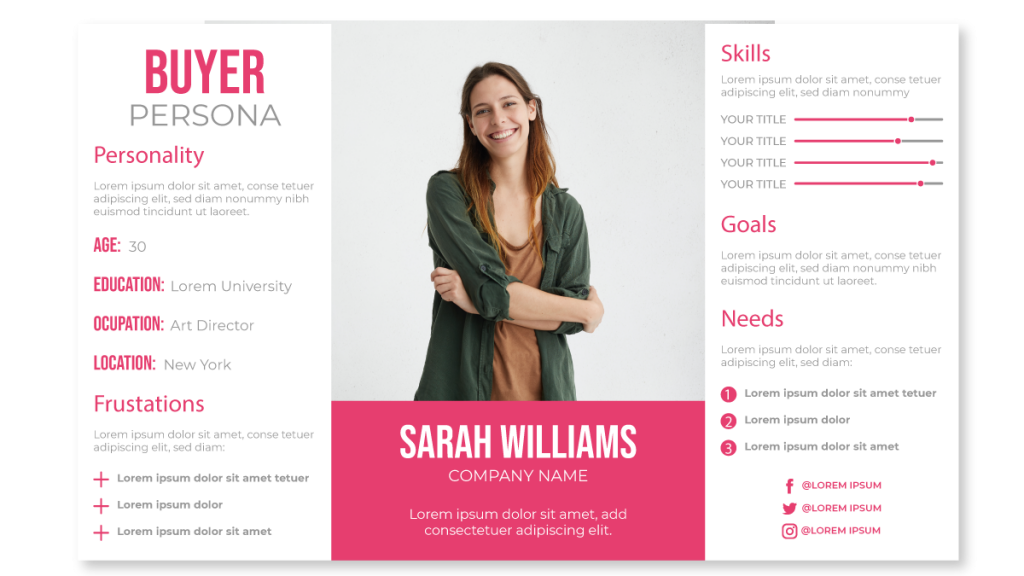
Es aquel segmento de clientes en el que debes de concentrar todos tus esfuerzos para crear tu empresa. En la fase anterior has descubierto muchísimos posibles segmentos de clientes, tienes una lista muy larga y eso es bueno pero no pueden empezar con todos a la vez, tienes que seleccionar solo un segmento. Ya tendrás tiempo de diversificar a futuro cuando hayas conquistando tu primer segmento de clientes
¿Cómo seleccionar el segmento de clientes que más te conviene para empezar a poner en marcha tu empresa?
Para seleccionar el segmento de clientes que más conviene para empezar a poner en marcha una empresa, se pueden seguir los siguientes pasos:
- Identificar todos los segmentos de mercado potenciales: se debe realizar una investigación para identificar los diferentes segmentos de mercado que podrían estar interesados en los productos o servicios que se ofrecen.
- Analizar la competencia: se debe analizar la competencia para conocer qué segmentos de mercado están atendiendo y cómo lo están haciendo.
- Evaluar la capacidad de la empresa: se debe evaluar la capacidad de la empresa para atender a los diferentes segmentos de mercado, teniendo en cuenta la experiencia, los recursos y las habilidades.
- Identificar el segmento de mercado donde más rentable: se debe evaluar la rentabilidad de cada segmento de mercado potencial y seleccionar el que ofrezca la mayor rentabilidad, o mejor con el que más rápido puedas crecer
- Realizar pruebas piloto: se pueden realizar pruebas piloto con diferentes segmentos de mercado para evaluar cuál es el más adecuado. Intenta vender a 10 clientes de cada segmento y compara en que segmento has obtenido mejores resultados.
Al seguir estos pasos, se puede seleccionar el segmento de clientes que más conviene para poner en marcha una empresa y así maximizar las posibilidades de éxito.
¿Qué es un buyer persona?
Un buyer persona es una representación ficticia y detallada de un cliente ideal basada en datos demográficos, psicográficos y de comportamiento. El objetivo de crear un buyer persona es ayudar a las empresas a entender mejor a su público objetivo y adaptar su estrategia de marketing y ventas para satisfacer las necesidades de los clientes. Al tener una comprensión clara de los intereses, necesidades, comportamientos y motivaciones de su buyer persona, las empresas pueden crear mensajes más efectivos, tomar mejores decisiones de marketing y ventas, y mejorar su capacidad para atraer y retener clientes.
Para crear un buyer persona, se deben realizar investigaciones de mercado y recopilar datos de diferentes fuentes, como encuestas, entrevistas con clientes existentes, análisis de datos de ventas y redes sociales, entre otras. Los datos recopilados deben utilizarse para desarrollar un perfil detallado del cliente ideal, incluyendo información sobre su edad, género, ubicación geográfica, nivel de ingresos, intereses, comportamientos de compra y otros factores relevantes.
Una vez que se ha creado el buyer persona, es importante utilizarlo en todas las etapas del proceso de marketing y ventas, desde la creación de contenido hasta la publicidad y la segmentación de anuncios. Al tener una comprensión clara de las necesidades y deseos de su público objetivo, las empresas pueden crear mensajes más efectivos y personalizados, mejorar su retorno de inversión en publicidad y aumentar su tasa de conversión de clientes potenciales a clientes reales.
Ventajas de tener bien identificado tu buyer persona
Según estudios publicados, disponer de un buyer persona identificado supone ventajas como un aumento del 900% en la duración de la visita al sitio web, un crecimiento del 171% en los ingresos generados por marketing, un aumento del 111% en la tasa de apertura de correo electrónico y un aumento del 100% en el número de páginas visitadas. Los clientes tienen un 48% más de probabilidades de contratar empresas que personalizan su marketing. En este sentido, ya no se trata solo de buscar el público objetivo, sino dar un paso más y lograr perfilar el que será el buyer persona, que no es otra cosa que una representación de un personaje ficticio, pero que simboliza a personas muy reales: los clientes.
Consejos para que un emprendedor identifique a su buyer persona
Es un esquema detallado de quién es exactamente la persona que investiga, compra y comparte el producto/servicio en cuestión. Además, sirve para conocer a los compradores en profundidad y también para tener un enfoque más cercano a los problemas reales que puedan sufrir, y, por lo tanto, nos ayudará a conseguir mejores resultados. Aquí te dejamos algunos consejos para que un emprendedor pueda identificar a su buyer persona:
- Investiga a tu audiencia: para conocer a tu buyer persona debes realizar una investigación profunda sobre los posibles clientes que se interesen en tu producto o servicio. Debes conocer sus necesidades, deseos, problemas y objetivos.
- Segmenta tu mercado: para poder llegar a tu buyer persona debes segmentar tu mercado, de manera que puedas ofrecerle el contenido adecuado a cada grupo. Puedes utilizar diversas herramientas para segmentar tu mercado como Google Analytics, redes sociales, encuestas, entre otros.
- Realiza encuestas y entrevistas: las encuestas y entrevistas son excelentes herramientas para conocer a tu buyer persona. Puedes utilizar plataformas como Google Forms, Typeform o SurveyMonkey para realizar encuestas en línea y obtener información relevante.
- Crea un perfil de tu buyer persona: utiliza toda la información que hayas obtenido para crear un perfil detallado de tu buyer persona. Incluye información sobre sus características demográficas, intereses, comportamientos, necesidades y objetivos.
- Utiliza la información obtenida: utiliza la información obtenida para personalizar tu contenido y ajustarlo a las necesidades de tu buyer persona. De esta manera, podrás crear una conexión más cercana con tus clientes potenciales y aumentar la posibilidad de convertirlos en clientes reales.
Recuerda que identificar correctamente a tu buyer persona es fundamental para el éxito de tu negocio.
¿Qué técnicas hay para identificar buyer persona?
Hay varias técnicas que se pueden utilizar para identificar al buyer persona de una empresa:
- Realizar encuestas y entrevistas a los clientes actuales para conocer sus características, necesidades, hábitos de consumo y opiniones sobre el producto o servicio.
- Analizar datos demográficos, geográficos y psicográficos de los clientes actuales y potenciales, como edad, género, ubicación geográfica, ingresos, intereses, entre otros.
- Utilizar herramientas de análisis de datos y Big Data para conocer el comportamiento de los clientes en la web, en las redes sociales y en otras plataformas digitales.
- Estudiar la competencia y sus clientes para conocer sus fortalezas y debilidades y compararlas con las de la propia empresa.
- Realizar observaciones de campo para conocer los comportamientos y necesidades de los clientes en su entorno natural, como en tiendas, eventos o lugares de reunión.
Es importante utilizar varias técnicas y herramientas para obtener una imagen completa y precisa del buyer persona y evitar tomar decisiones basadas en suposiciones o prejuicios.
Ejemplos de buyer persona en empresas muy conocidas
- Apple: enfoca sus productos a personas creativas y de mente abierta que valoran la estética y la calidad.
- Nike: dirige sus productos a personas activas y deportivas que valoran la comodidad, el estilo y la calidad.
- Coca-Cola: se enfoca en personas jóvenes que quieren disfrutar la vida y que valoran la felicidad y el compartir momentos con amigos.
- Amazon: se enfoca en personas que valoran la conveniencia y la facilidad de uso, y que desean tener una amplia selección de productos a su alcance.
- Airbnb: se enfoca en personas que valoran la experiencia y la autenticidad, y que desean vivir como un local en su destino de viaje.
Cada una de estas empresas ha creado una imagen detallada de su buyer persona, lo que les permite desarrollar productos y campañas de marketing que resuenen con su público objetivo. ¡Por supuesto! Aquí tienes un caso práctico de cómo un emprendedor podría identificar a su buyer persona:
CASO PRÁCTICO
Luis es un emprendedor que quiere lanzar una tienda en línea que venda productos veganos y ecológicos. Para identificar a su buyer persona, Luis decide seguir los siguientes pasos:
- Investiga sobre su nicho de mercado: Luis investiga en línea y descubre que hay un creciente interés en los productos veganos y ecológicos en su zona geográfica. También investiga a la competencia y encuentra que hay varias tiendas en línea que venden productos similares.
- Define su oferta de productos: Luis decide que su tienda en línea ofrecerá principalmente productos veganos y ecológicos de alta calidad. También decide ofrecer un servicio de entrega rápida y atención al cliente personalizada.
- Identifica a su buyer persona: Luis quiere dirigirse a una audiencia joven y comprometida con el medio ambiente y los derechos de los animales. Para ello, decide que su buyer persona será una mujer de entre 25 y 35 años, que vive en la ciudad, trabaja a tiempo completo y tiene un estilo de vida saludable y activo. Esta persona está interesada en la comida vegana y ecológica y está dispuesta a pagar un poco más por productos de alta calidad.
- Refina su buyer persona: Luis se da cuenta de que su buyer persona necesita ser más específica. Decide hacer encuestas a través de redes sociales para conocer más a fondo a su público objetivo. Pregunta sobre sus hábitos de consumo, preferencias alimentarias, ingresos, y más. Con esta información, Luis puede refinar su buyer persona y adaptar su estrategia de marketing y productos a las necesidades de su audiencia.
- Crea contenido adaptado a su buyer persona: Luis comienza a crear contenido para su tienda en línea que se adapte a su buyer persona, incluyendo recetas veganas y ecológicas, consejos sobre alimentación saludable y sostenible, y noticias sobre productos y eventos relacionados con el veganismo y el medio ambiente.
Con estos pasos, Luis ha logrado identificar a su buyer persona y adaptar su estrategia de marketing y productos para satisfacer sus necesidades y deseos. Esto le permitirá tener una estrategia más enfocada y efectiva para llegar a su público objetivo y hacer crecer su negocio.
Claves para identificar a tu Buyer persona
Pero; ¿Cómo llegamos a él? ¿Qué pasos hay que seguir para lograr dibujar al comprador ideal?
Dibujar tu buyer persona aumenta un 900% la duración de su visita en tu web
Lo primero que hay que tener en cuenta, es que la creación del buyer persona se complete en la fase estratégica. De esta forma, se garantiza que todo el contenido, diseño, seguimiento de oportunidades de venta y, en definitiva, cualquier actividad del plan de marketing que se vaya a llevar a cabo esté ya pensado para un cliente ideal.
¿Cómo dibujar a tu buyer persona?
- Encuesta entre los clientes. Una de las primeras claves que hay que tener en cuenta es la realización de una encuesta entre los clientes actuales de la empresa. Esto nos ayudará a establecer gustos, preferencias o incluso posibles problemas a subsanar, ¿Qué les frena a comprar? ¿Qué les motiva a la hora de adquirir un producto o servicio? O, por ejemplo, ¿Cuáles son sus hábitos de consumo?, entre otras, contribuyen en la confección de nuestro buyer persona”.
- Entrevista en profundidad a 5 perfiles. Una vez realizada la encuesta con las preferencias generales de los clientes, es necesario analizar de una forma más exhaustiva a 5 perfiles concretos para tener una aproximación cualitativa. Así, se tiene una visión más “de tú a tú” sobre las problemáticas más particulares.
- Sinergias con la venta. El objetivo es aprender de la venta ventas. Los vendedores al final del día son los que más interactúan con los usuarios, por lo tanto, la información que pueden aportarnos sobre el comportamiento de los clientes es de un valor incalculable. Todos los miembros de la organización deben comprender de verdad las problemáticas más comunes -y del día a día- que viven las personas a las que desean ofertar productos/servicios
- Revisión del chat de la empresa y últimos formularios recibidos. Realizar un histórico exhaustivo de los canales de atención al cliente es un paso esencial a la hora de elaborar el buyer persona. El chat de atención al cliente de la empresa, los últimos formularios recibidos e, incluso, el buzón de sugerencias y quejas aportan información clave a tener en cuenta. A través del análisis de este tipo de elementos de interacción se podrá discernir sobre las características definitorias de los clientes, de sus reclamaciones, gustos y preferencias, entre otros.
- Encuesta en LinkedIn. Por último, lanzar una encuesta en LinkedIn facilitará también abarcar a ese público objetivo y poder así confeccionar un perfil del buyer persona más definido. Una vez recopilada toda la información extraída tras la realización de estos 5 pasos se debe elaborar un documento donde se encontrarán agrupados los datos más relevantes sobre el cliente como, por ejemplo, los datos demográficos, los miedos, los objetivos o los principales retos que persigue.







